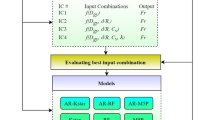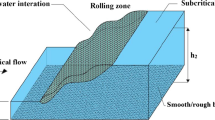Abstract
Flow resistance in natural gravel-bed rivers must be precisely predicted in order for water-related infrastructure to be designed effectively. Cluster microforms are significant factors in determining the resistance of flow in rivers with gravel beds. To precisely estimate the cluster microform-induced Darcy-Weisbach roughness coefficient, the current study utilized two novel and robust data-intelligence paradigms: Unscented Kalman Filter (UKF) and Extended Kalman Filter (EKF) -based Artificial Neural Networks (UKF-ANN and EKF-ANN), in addition to Response Surface Methodology (RSM) and Multi-layer Perceptron Neural Network (MLPNN). A total of 128 sets of laboratory data were used to develop the models, which encompassed a range of geometric and hydraulic scenarios. Various performance metrics, including, Mean Absolute Percentage Error (MAPE) Root Mean Square Error (RMSE) and Correlation Coefficient (R) were employed to assess the models' performance. The results showed that the implemented machine learning methods (i.e., MLPNN, UKF-ANN, EKF-ANN) had a good performance. Comparison of machine learning models showed that the EKF-ANN (R = 0.9747, MAPE = 7.73, RMSE = 0.0041) and UKF-ANN (R = 0.9617, MAPE = 8.17, RMSE = 0.0050) models provided higher accuracy compared to MLPNN (R = 0.940, MAPE = 11.38, RMSE = 0.0064,) and RSM (R = 0.957, MAPE = 11.02, RMSE = 0.0057). Moreover, the sensitivity analysis demonstrates that the roughness coefficient is primarily affected by the hydraulic radius to the longitudinal distance of clusters (R/λ).












Similar content being viewed by others
Data Availability
The data utilized or analyzed in this study are available upon a reasonable request from the corresponding author.
References
Asadollah SBHS, Sharafati A, Motta D, Yaseen ZM (2021) River water quality index prediction and uncertainty analysis: A comparative study of machine learning models. J Environ Chem Eng 9:104599. https://doi.org/10.1016/j.jece.2020.104599
Asheghi R, Hosseini SA, Sanei M (2022) Intelligent hybridized modeling approach to predict the bedload sediments in gravel-bed rivers. Model Earth Syst Environ 8:1991–2000
Aubert D, Loumagne C, Oudin L (2003) Sequential assimilation of soil moisture and streamflow data in a conceptual rainfall - Runoff model. J Hydrol. https://doi.org/10.1016/S0022-1694(03)00229-4
Aydogmus Z, Aydogmus O (2015) A comparison of artificial neural network and extended Kalman filter based sensorless speed estimation. Meas J Int Meas Confed. https://doi.org/10.1016/j.measurement.2014.12.010
Azamathulla HM, Jarrett RD (2013) Use of Gene-Expression Programming to Estimate Manning’s Roughness Coefficient for High Gradient Streams. Water Resour Manag 27:715–729. https://doi.org/10.1007/s11269-012-0211-1
Azamathulla HM, Ghani AA, Leow CS et al (2011) Gene-expression programming for the development of a stage-discharge curve of the Pahang River. Water Resour Manag 25:2901–2916
Brayshaw AC, Frostick LE, Reid IAN (1983) The hydrodynamics of particle clusters and sediment entrapment in coarse alluvial channels. Sedimentology 30:137–143
Chui CK, Chen G (2017) Extended Kalman filter and system identification. In: Kalman Filtering. Springer, Book Chapter, pp 115–137
Darojah Z, Ningrum ES (2016) The extended Kalman filter algorithm for improving neural network performance in voice recognition classification. In: 2016 International Seminar on Intelligent Technology and Its Applications (ISITIA). IEEE, pp 225–230
Eslamian S, Eslamian FA (2022) Flood Handbook: Impacts and Management. CRC Press
Faramarzzadeh M, Ehsani MR, Akbari M et al (2023) Application of machine learning and remote sensing for gap-filling daily precipitation data of a sparsely gauged basin in East Africa. Environ Process 10:8
Gharamti ME, Hoteit I (2014) Complex step-based low-rank extended Kalman filtering for state-parameter estimation in subsurface transport models. J Hydrol. https://doi.org/10.1016/j.jhydrol.2013.12.004
Gholizadeh M, Jamei M, Ahmadianfar I, Pourrajab R (2020) Prediction of nanofluids viscosity using random forest (RF) approach. Chemom Intell Lab Syst 201:104010. https://doi.org/10.1016/j.chemolab.2020.104010
Ghose DK, Samantaray S (2019) Sedimentation process and its assessment through integrated sensor networks and machine learning process. In: Computational intelligence in sensor networks. Springer, Book Chapter, pp 473–488
Goegebeur M, Pauwels VRN (2007) Improvement of the PEST parameter estimation algorithm through Extended Kalman Filtering. J Hydrol. https://doi.org/10.1016/j.jhydrol.2007.02.006
Gómez RD, Pasternack GB, Guillon H et al (2022) Mapping subaerial sand-gravel-cobble fluvial sediment facies using airborne lidar and machine learning. Geomorphology 401:108106
Gundogdu A, Celikel R, Aydogmus O (2020) Comparison of SI-ANN and Extended Kalman Filter-Based Sensorless Speed Controls of a DC Motor. Arab J Sci Eng. https://doi.org/10.1007/s13369-020-05014-3
Gutierrez RR, Lefebvre A, Núñez-González F, Avila H (2020) Towards adopting open and data-driven science practices in bed form dynamics research, and some steps to this end. Earth Surf Process Landforms
Hammoudi A, Moussaceb K, Belebchouche C, Dahmoune F (2019) Comparison of artificial neural network (ANN) and response surface methodology (RSM) prediction in compressive strength of recycled concrete aggregates. Constr Build Mater 209:425–436
Haykin S, Network N (2004) A Comprehensive Foundation. Neural Networks 2:41
Hornik K (1991) Approximation capabilities of multilayer feedforward networks. Neural Netw 4:251–257. https://doi.org/10.1016/0893-6080(91)90009-t
Hornik K, Stinchcombe M, White H (1989) Multilayer feedforward networks are universal approximators. Neural Netw 2:359–366. https://doi.org/10.1016/0893-6080(89)90020-8
Hosseinzadeh A, Najafpoor AA, Jafari AJ et al (2018) Application of response surface methodology and artificial neural network modeling to assess non-thermal plasma efficiency in simultaneous removal of BTEX from waste gases: Effect of operating parameters and prediction performance. Process Saf Environ Prot 119:261–270
Jamei M, Olumegbon IA, Karbasi M et al (2021) On the Thermal Conductivity Assessment of Oil-Based Hybrid Nanofluids using Extended Kalman Filter integrated with feed-forward neural network. Int J Heat Mass Transf 172:121159
Jamei M, Karbasi M, Alawi OA et al (2022) Earth skin temperature long-term prediction using novel extended Kalman filter integrated with Artificial Intelligence models and information gain feature selection. Sustain Comput Informatics Syst 35:100721
Jin C, Jang S, Sun X et al (2016) Damage detection of a highway bridge under severe temperature changes using extended Kalman filter trained neural network. J Civ Struct Heal Monit 6:545–560
Johnson JPL (2017) Clustering statistics, roughness feedbacks, and randomness in experimental step-pool morphodynamics. Geophys Res Lett 44:3653–3662
Julier SJ, Uhlmann JK (2004) Unscented filtering and nonlinear estimation. Proc IEEE 92(3):401–422
Kalman RE (1960) A new approach to linear filtering and prediction problems. J Fluids Eng Trans ASME 10(1115/1):3662552
Karbasi M, Ghasemian M, Asadi M (2018) Experimental investigation of the effect of different cluster shapes on flow resistance coefficient. J Water Soil Conversat 25:203–218
Karunasingha DSK, Liong SY (2018) Enhancement of chaotic hydrological time series prediction with real-time noise reduction using Extended Kalman Filter. J Hydrol. https://doi.org/10.1016/j.jhydrol.2018.08.044
Kitsikoudis V, Sidiropoulos E, Iliadis L, Hrissanthou V (2015) A machine learning approach for the mean flow velocity prediction in alluvial channels. Water Resour Manag 29:4379–4395
Milukow HA, Binns AD, Adamowski J et al (2019) Estimation of the Darcy-Weisbach friction factor for ungauged streams using Gene Expression Programming and Extreme Learning Machines. J Hydrol 568:311–321
Muluye GY (2011) Improving long-range hydrological forecasts with extended Kalman filters. Hydrol Sci J. https://doi.org/10.1080/02626667.2011.608068
Pandey M, Karbasi M, Jamei M et al (2023) A Comprehensive Experimental and Computational Investigation on Estimation of Scour Depth at Bridge Abutment: Emerging Ensemble Intelligent Systems. Water Resour Manag 37:3745–3767. https://doi.org/10.1007/s11269-023-03525-w
Patino CM, Ferreira JC (2015) Confidence intervals: a useful statistical tool to estimate effect sizes in the real world. J Bras Pneumol. https://doi.org/10.1590/s1806-37562015000000314
Piraei R, Afzali SH, Niazkar M (2023) Assessment of XGBoost to estimate total sediment loads in rivers. Water Resour Manag 37:5289–5306
Rehamnia I, Benlaoukli B, Jamei M et al (2021) Simulation of seepage flow through embankment dam by using a novel extended Kalman filter based neural network paradigm: Case study of Fontaine Gazelles Dam. Algeria Measurement 176:109219. https://doi.org/10.1016/j.measurement.2021.109219
Reif K, Unbehauen R (1999) The extended kalman filter as an exponential observer for nonlinear systems. IEEE Trans Signal Process 47(8):2324–2328. https://doi.org/10.1109/78.774779
Roushangar K, Shahnazi S (2020) Prediction of sediment transport rates in gravel-bed rivers using Gaussian process regression. J Hydroinformatics 22:249–262
Roushangar K, Mouaze D, Shiri J (2014) Evaluation of genetic programming-based models for simulating friction factor in alluvial channels. J Hydrol 517:1154–1161
Roushangar K, Alami MT, Saghebian SM (2018a) Modeling open channel flow resistance with dune bedform via heuristic and nonlinear approaches. J Hydroinformatics 20:356–375
Roushangar K, Alipour SM, Mouaze D (2018b) Linear and non-linear approaches to predict the Darcy-Weisbach friction factor of overland flow using the extreme learning machine approach. Int J Sediment Res 33:415–432
Sabour MR, Besharati M, Dezvareh GA et al (2022) Application of artificial neural network with the back-propagation algorithm for estimating the amount of polycyclic aromatic hydrocarbons in Tehran Oil Refinery Iran. Environ Nanotechnol, Monit Manag 18:100677
Saghebian SM, Roushangar K, Ozgur Kirca VS, Ghasempour R (2020) Modeling total resistance and form resistance of movable bed channels via experimental data and a kernel-based approach. J Hydroinformatics 22:528–540
Sahoo A, Samantaray S, Ghose DK (2021) Prediction of flood in Barak River using hybrid machine learning approaches: a case study. J Geol Soc India 97:186–198
Sahoo BB, Sankalp S, Kisi O (2023) A Novel Smoothing-Based Deep Learning Time-Series Approach for Daily Suspended Sediment Load Prediction. Water Resour Manag 37:4271–4292
Samadianfard S, Taghi Sattari M, Kisi O, Kazemi H (2014) Determining flow friction factor in irrigation pipes using data mining and artificial intelligence approaches. Appl Artif Intell 28:793–813
Sarve A, Sonawane SS, Varma MN (2015) Ultrasound assisted biodiesel production from sesame (Sesamum indicum L.) oil using barium hydroxide as a heterogeneous catalyst: comparative assessment of prediction abilities between response surface methodology (RSM) and artificial neural network (ANN). Ultrason Sonochem 26:218–228
Shahsavar A, Mirzaei MA, Shaham A et al (2022) Experimental exploration of rheological behavior of polyethylene glycol-carbon dot nanofluid: Introducing a robust artificial intelligence paradigm optimized with unscented Kalman filter technique. J Mol Liq 358:119198
Song T, Chiew YM, Chin CO (1998) Effect of bed-load movement on flow friction factor. J Hydraul Eng 124:165–175
Sun L, Nistor I, Seidou O (2015) Streamflow data assimilation in SWAT model using Extended Kalman Filter. J Hydrol. https://doi.org/10.1016/j.jhydrol.2015.10.060
Sun L, Seidou O, Nistor I et al (2016) Simultaneous assimilation of in situ soil moisture and streamflow in the SWAT model using the Extended Kalman Filter. J Hydrol. https://doi.org/10.1016/j.jhydrol.2016.10.040
Ullah I, Su X, Zhu J et al (2020) Evaluation of localization by extended kalman filter, unscented kalman filter, and particle filter-based techniques. Wirel Commun Mob Comput. https://doi.org/10.1155/2020/8898672
Wan EA, Van Der Merwe R (2000) The unscented Kalman filter for nonlinear estimation. In: IEEE 2000 Adaptive Systems for Signal Processing, Communications, and Control Symposium, AS-SPCC 2000, pp 153–158
Welch G, Bishop G (1995) An introduction to the Kalman filter. http://www.cs.unc.edu/~welch
Whittaker JG (1987) Sediment transport in step-pool streams. Sediment Transport Gravel-Bed Rivers. John Wiley Sons, New York, pp 545–579
Willmott CJ, Robeson SM, Matsuura K (2012) A refined index of model performance. Int J Climatol 32:2088–2094
Wohl EE (2000) Mountain rivers. American Geophysical Union
Wu X, Wang Y (2012) Extended and Unscented Kalman filtering based feedforward neural networks for time series prediction. Appl Math Model 36:1123–1131
Yeh HD, Huang YC (2005) Parameter estimation for leaky aquifers using the extended Kalman filter, and considering model and data measurement uncertainties. J Hydrol. https://doi.org/10.1016/j.jhydrol.2004.06.035
Yen BC (2002) Open channel flow resistance. J Hydraul Eng 128:20–39
Funding
Not available.
Author information
Authors and Affiliations
Contributions
Masoud Karbasi: Supervisor, Conceptualization, Software Analysis, writing, Modelling, Visualization Mohammad Ghasemian: Data collection, Experiments, writing. Mehdi Jamei: Formal analysis, Visualization, writing up the manuscript. Anurag Malik: Writing up the manuscript. Ozgur Kisi: Editing, and Review.
Corresponding author
Ethics declarations
Ethical Approval
There were no animal or human subjects involved in any of the studies conducted for this research, and no private or protected areas were utilised. There were no explicit permission requirements for the corresponding locations.
Consent to Participate
Not applicable.
Competing Interests
The authors declare no competing interests.
Consent to Publish
Not applicable.
Additional information
Publisher's Note
Springer Nature remains neutral with regard to jurisdictional claims in published maps and institutional affiliations.
Rights and permissions
Springer Nature or its licensor (e.g. a society or other partner) holds exclusive rights to this article under a publishing agreement with the author(s) or other rightsholder(s); author self-archiving of the accepted manuscript version of this article is solely governed by the terms of such publishing agreement and applicable law.
About this article
Cite this article
Karbasi, M., Ghasemian, M., Jamei, M. et al. Developing Extended and Unscented Kalman Filter-Based Neural Networks to Predict Cluster-Induced Roughness in Gravel Bed Rivers. Water Resour Manage 38, 3023–3048 (2024). https://doi.org/10.1007/s11269-024-03803-1
Received:
Accepted:
Published:
Issue Date:
DOI: https://doi.org/10.1007/s11269-024-03803-1




